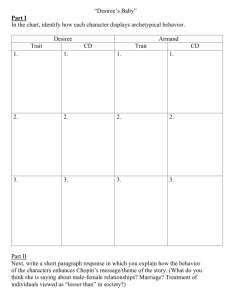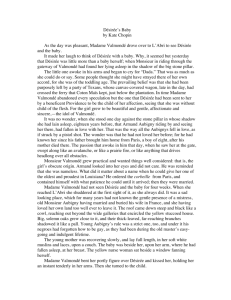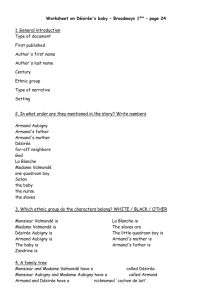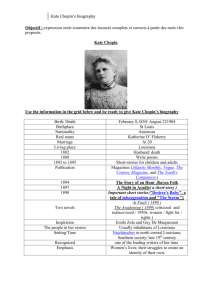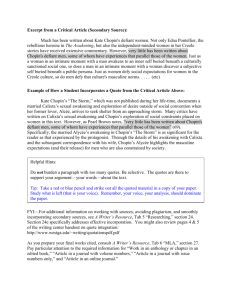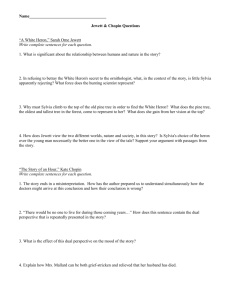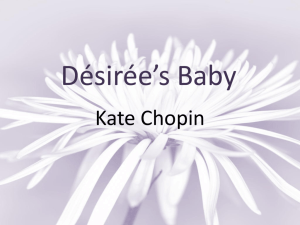Themes and Meanings in The Storm by K. Chopin When Kate
advertisement
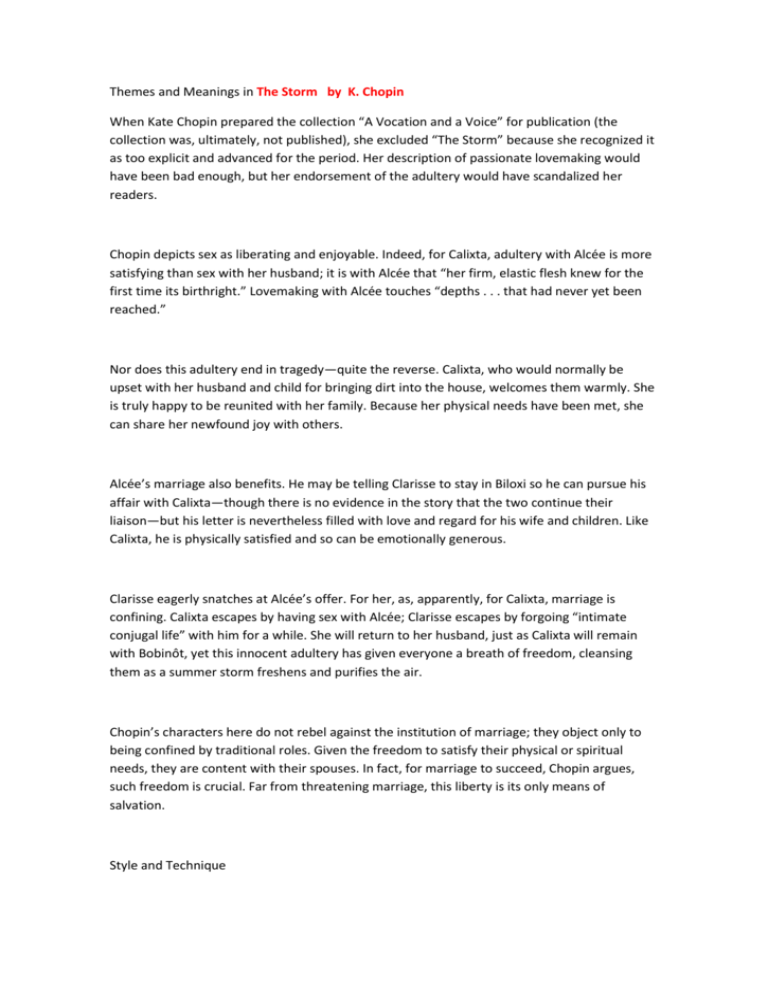
Themes and Meanings in The Storm by K. Chopin When Kate Chopin prepared the collection “A Vocation and a Voice” for publication (the collection was, ultimately, not published), she excluded “The Storm” because she recognized it as too explicit and advanced for the period. Her description of passionate lovemaking would have been bad enough, but her endorsement of the adultery would have scandalized her readers. Chopin depicts sex as liberating and enjoyable. Indeed, for Calixta, adultery with Alcée is more satisfying than sex with her husband; it is with Alcée that “her firm, elastic flesh knew for the first time its birthright.” Lovemaking with Alcée touches “depths . . . that had never yet been reached.” Nor does this adultery end in tragedy—quite the reverse. Calixta, who would normally be upset with her husband and child for bringing dirt into the house, welcomes them warmly. She is truly happy to be reunited with her family. Because her physical needs have been met, she can share her newfound joy with others. Alcée’s marriage also benefits. He may be telling Clarisse to stay in Biloxi so he can pursue his affair with Calixta—though there is no evidence in the story that the two continue their liaison—but his letter is nevertheless filled with love and regard for his wife and children. Like Calixta, he is physically satisfied and so can be emotionally generous. Clarisse eagerly snatches at Alcée’s offer. For her, as, apparently, for Calixta, marriage is confining. Calixta escapes by having sex with Alcée; Clarisse escapes by forgoing “intimate conjugal life” with him for a while. She will return to her husband, just as Calixta will remain with Bobinôt, yet this innocent adultery has given everyone a breath of freedom, cleansing them as a summer storm freshens and purifies the air. Chopin’s characters here do not rebel against the institution of marriage; they object only to being confined by traditional roles. Given the freedom to satisfy their physical or spiritual needs, they are content with their spouses. In fact, for marriage to succeed, Chopin argues, such freedom is crucial. Far from threatening marriage, this liberty is its only means of salvation. Style and Technique The storm is the story’s central metaphor, representing the passion of Calixta and Alcée. By linking the two, Chopin indicates that the lovers’ feelings are natural and therefore not subject to moral censure. She reinforces this idea through other imagery drawn from nature, likening Alcée to the sun and Calixta to a lily and a pomegranate. Not only do these images come from nature, but they also derive from the biblical book The Song of Songs, giving a kind of religious sanction to the lovers’ union. The storm is not only natural but also powerful, like the passions it symbolizes. While Calixta and Alcée make love, the thunder crashes and the elements roar; the passing of the storm indicates their physical exhaustion. While these passions, like the storm, are strong, they are not destructive. The storm does little damage, and when it passes the sun emerges, “turning the glistening green world into a palace of gems.” The rain leaves the world a happier and more beautiful place, just as the lovers part with joy in their hearts. Alcée leaves with a smile, and Calixta answers him with laughter. Chopin uses language to indicate that this joy derives from the lovers’ equality. He is like the sun and she is a “white flame.” She cushions but also clasps him, being both active and passive. His heart beats “like a hammer upon her” while she “strokes his shoulders.” They “swoon together at the very borderland of life’s mystery.” In this union of true love there is neither master nor mastered—simply two partners who share desire and fulfillment. For Chopin, that is the only proper relationship between the sexes, the only one likely to bring happiness within marriage . While there are multiple themes at work in this short story, the central themes arise from the seemingly nonchalant attitude toward infidelity in a marriage and a woman who follows sexual desires. Issues Chopin seems to be raising include: •Roles of Love and Sex in Marriage •Women’s Sexuality •Honesty •Guilt/Lack of Guilt Although considered a controversial story, particularly for the time it was written and the themes involved, “The Storm” remains a classic in the canon of American Literature. The stories plot is reinforced by the setting of the storm, the two mirroring one another throughout the story. Some readers believe that the setting causes the plot in this story. Whether or not this is the case is debatable, but plot and setting are closely intertwined The Story of an Hour by K Chopin: Themes . Identity and Selfhood Chopin deals with the issues of female self-discovery and identity in "The Story of an Hour." After Mrs. Mallard learns of her husband's death, she is initially overcome with grief. But quickly she begins to feel a previously unknown sense of freedom and relief. At first, she is frightened of her own awakening: "There was something coming to her and she was waiting for it, fearfully." Her own feelings come upon her, possessing her. When she first utters the words "free, free, free!" she is described as having "abandoned herself." But after she speaks these words, she relaxes and gains more control over herself. As she imagines life without her husband, she embraces visions of the future. She realizes that whether or not she had loved him was less important than "this possession of self-assertion" she now feels. The happiness Louise gains by this recognition of selfhood is so strong that, when she realizes that her husband is in fact alive, she immediately collapses. Chopin suggests that Louise could not bear to abandon her newfound freedom and return to life with her husband, where she would be required to bend her will to his. Role of Women in Marriage Intimately connected with the theme of identity and selfhood is the theme of the role of women in marriage. Mrs. Mallard is known in the beginning of the story only as a wife; very little is revealed concerning Mr. and Mrs. Mallard's relationship. Even Louise is unsure whether or not they had been happily married: "And yet she had loved him—sometimes. Often she had not. What did it matter!" Thus, the specifics of the relationship matter less than the conventions of marriage in general. Louise is ecstatic when she realizes that ''there would be no powerful will bending hers in that blind persistence with which men and women believe they have a right to impose a private will upon a fellow-creature." Whether one is acting out of love or not, Chopin seems to be making a comment on nineteenth-century marriages, which granted one person—the man—right to own and dominate another—the woman. This theme, unpopular in an era when women were not even allowed to vote, is examined in many of Chopin's other works, most notably The Awakening. Desiree’s Baby . Themes Race and Racism The themes of race and racism are integral to ‘‘Désirée's Baby,’’ for prevailing ideas of Chopin's time that African Americans were inferior to whites leads to the destruction of Désirée and her baby. Armand is confident in the superiority of his lineage and his race. He comes from ''one of the oldest and proudest [families] in Louisiana.’’ Armand conducts himself in a way typical of the cruel master of southern legend. In marked contrast to his father, he rules his slaves strictly, and Désirée's delight in his initial good mood after the birth of the baby demonstrates his true nature: ‘‘he hasn't punished one of them [the slaves]—not one of them—since baby is born.’’ When the child begins to show evidence of being of mixed ancestry, Armand believes it must be Désirée's unknown ancestors who have tainted his family and brought ‘‘unconscious injury ... upon his home and his name.’’ He rejects both his wife and child because they are ‘‘not white.’’ Yet, the irrationality of such racism is demonstrated at the end of the story when Armand discovers that it is he who is of mixed ancestry, not Désirée. Such a reversal clearly shows that ideas of race, and the racism stemming from such ideas, are created by humans alone. Love Love—and what this means to different people—is inherent in ‘‘Désirée's Baby.’’ Armand hardly seems to truly love Désirée; rather, he ''had fallen in love with her ... as if struck by a pistol shot.’’ It seems more a passion that he feels for Désirée, not any deep-seated feeling or emotion. Indeed, Armand has known Désirée for years and never felt any feelings for her. Although the softening effect their marriage has on Armand is apparent—and this could derive from love—Armand seems to view Désirée more as a possession, something that reflects his status. After the birth of their child, Armand's love for Désirée quickly dies, for she brings shame upon his name. That his love for her could so easily be transformed demonstrates its superficial quality. For her part, Désirée truly loves Armand. Her world seems to hinge on his thoughts and feelings. When he begins to avoid her, ''Désirée was miserable enough to die.’’ Maternal love is evident in the story as well. Madame Valmonde demonstrates the great depth of maternal love she feels in her desire to have Désirée return home, even after she "learns" of Désirée's child's African-American ancestry. She also demonstrates her continuing love for her grandchild in the invitation. The maternal love Armand's own mother felt for him can be seen in the letter he uncovers that his mother sent his father revealing how they hid from him the fact that his mother was of African descent. The logical explanation for this action is that his parents, who loved him, wanted to protect and shield him. Identity The theme of identity is important in ‘‘Désirée's Baby.’’ The circumstances of her childhood strip Désirée of any true identity of her own. Her adoption by the Valmondes gives her a new identity, and indeed, she ''grew to be beautiful and gentle, affectionate and sincere,—the idol of Valmonde.’’ However, Désirée's true lack of identity never ceases to exist. When Armand wants to marry her, Monsieur Valmonde reminds the suitor that ‘‘she was nameless.’’ Armand's insistence that her heritage doesn't matter, that he will give her his name, enforces the idea that once again a new identity is being imposed upon Désirée, even if it does not fit her. However, the issue of identity does not remain suppressed for long. Within a few months after the birth of their child, the identity of the son begins to be questioned. Désirée's mother and then Armand notice in him something they do not expect to see—evidence of African-American ancestry. That this turns out to come from Armand, and not Désirée, reinforces the idea that identity is not necessarily a fixed trait, but is derived as much from how others perceive a person as from qualities intrinsic to that person. That identity can so quickly change—for example, Armand who believes himself a proud, white man and superior to his slaves actually has African-American ancestors—demonstrates the capricious nature of naming and categorizing people based on family, appearance, or any other nonessential characteristic. Armand, though he later finds out the truth about his own heritage, wants Désirée to leave his house because she has besmirched his name through the child she bears. When Désirée leaves his house, she does not return to the Valmondes, as her mother implored. Her decision to walk off into the bayou with her child, to certain death, shows her inability to forge an identity for herself. She feels cut off from both of her former lives. She also may be grappling with the knowledge of her child's newly discovered African-American ancestry, though there is little evidence of that in the story. Instead, what seems to trouble her the most is her rejection by Armand. That her reaction to his rejection is so extreme demonstrates the depth of feeling she has regarding his love and her identity both being taken from her. Analysis in Beyond The Bayou by K Chopin The title of "Beyond the Bayou" is significant because it initially establishes the sense of boundary that is the centerpiece of La Folle's inner struggle. The main conflict in "Beyond the Bayou" is within a woman's mind as she suffers from her deeply ingrained fear of the unknown. As with a number of Chopin's short stories, such as "The Story of an Hour," the main character is a woman who discovers new aspects of her own independence and ability at a moment of crisis. Unlike Louise Mallard of "The Story of an Hour," however, La Folle is able to reclaim her liberty without any sudden setbacks, and the end of "Beyond the Bayou" features an image of triumph that associates a sunrise with La Folle's prospects for the future. Chopin initially introduces the bayou as a distinct line that cordons off her land from the remainder of the world so that her universe consists of a single hut and an abandoned field. The lack of people in this area contrasts with our knowledge of the crowdedness that exists beyond the bayou. Consequently, La Folle commences as a somewhat pitiable character who no longer bears her true name because her unreasoning fear creates a self-enforced boundary that restricts her both physically and mentally. By the end of her story, however, the situation of exigency created by Chéri's accident has allowed her to cross the barrier of the unknown as well as the social barrier that separates her enslaved existence from the residence of the owners of Bellissime. When the sun rises, it visually and symbolically breaks the bayou's boundary line so that La Folle is no longer constrained. The origin of La Folle's madness foreshadows the crisis that leads to the resolution both of the narrative and of La Folle's mental conflict. Kate Chopin describes La Folle's traumatic childhood experience as one where P'tit Maître returns bloodied to her mother's cabin while being pursued after a skirmish. Whereas a serious battle is implied in this incident, although the exact nature of the pursuers is never revealed, Chéri's misadventure is relatively trivial and involves a minor injury in which the ten-year-old shoots himself in the leg. The relative inconsequence of the accident contrasts with La Folle's reaction because she associates it with P'tit Maître's battle wounds and with her childhood fear. Unlike many of Chopin's stories about the antebellum South, "Beyond the Bayou" explores the world of the Louisiana plantation not from the viewpoint of the privileged upper class, as in "A Respectable Woman," but rather from the opposite end of the social spectrum. Although "Beyond the Bayou" does not deal as specifically with racial issues as does "Désirée's Baby," the bayou's division of La Folle's world from the plantation owners' house implicitly indicates La Folle's separation from the white upper class. Over the course of the story, the owners of Bellissime only enter La Folle's domain twice, in both cases to ask for help in a time of need. Conversely, when La Folle finds her sanity, her choice to walk first toward the door of P'tit Maître's home suggests that La Folle has also asserted her equality as a human being. That she is a slave bears no input on her status as the story's heroine or on her newfound freedom. A curious facet of La Folle's characterization is that her fear outweighs her physical stature, which exceeds that of most men on the plantation. Chopin's depiction of the effects of her fear uses auditory imagery, with a comparison of her heart's beating to the sound of a "muffled hammer" and an emphasis on her loud cries and unheeded voice. In this story, however, fear is counterbalanced by love, and love is eventually connected to La Folle's autonomy and mental independence. That love coincides with the ability to control one's life is not true in all of Chopin's works, which often feature love as destructive, as in "Désirée's Baby," or limiting, as in "The Story of an Hour." Yet, La Folle is fortunate, and her love for Chéri allows her to break her mental and physical boundaries. Independence and autonomy "Beyond the Bayou" ends with the main character La Folle realizing that the end of her fear of the world outside of the bayou's boundaries has given her a world of new possibilities. Class and Race In "Beyond the Bayou," Chopin provides another indication of the erroneous nature of nineteenth-century racial relations by revealing the black slave La Folle to be an inherently capable and strong woman.

